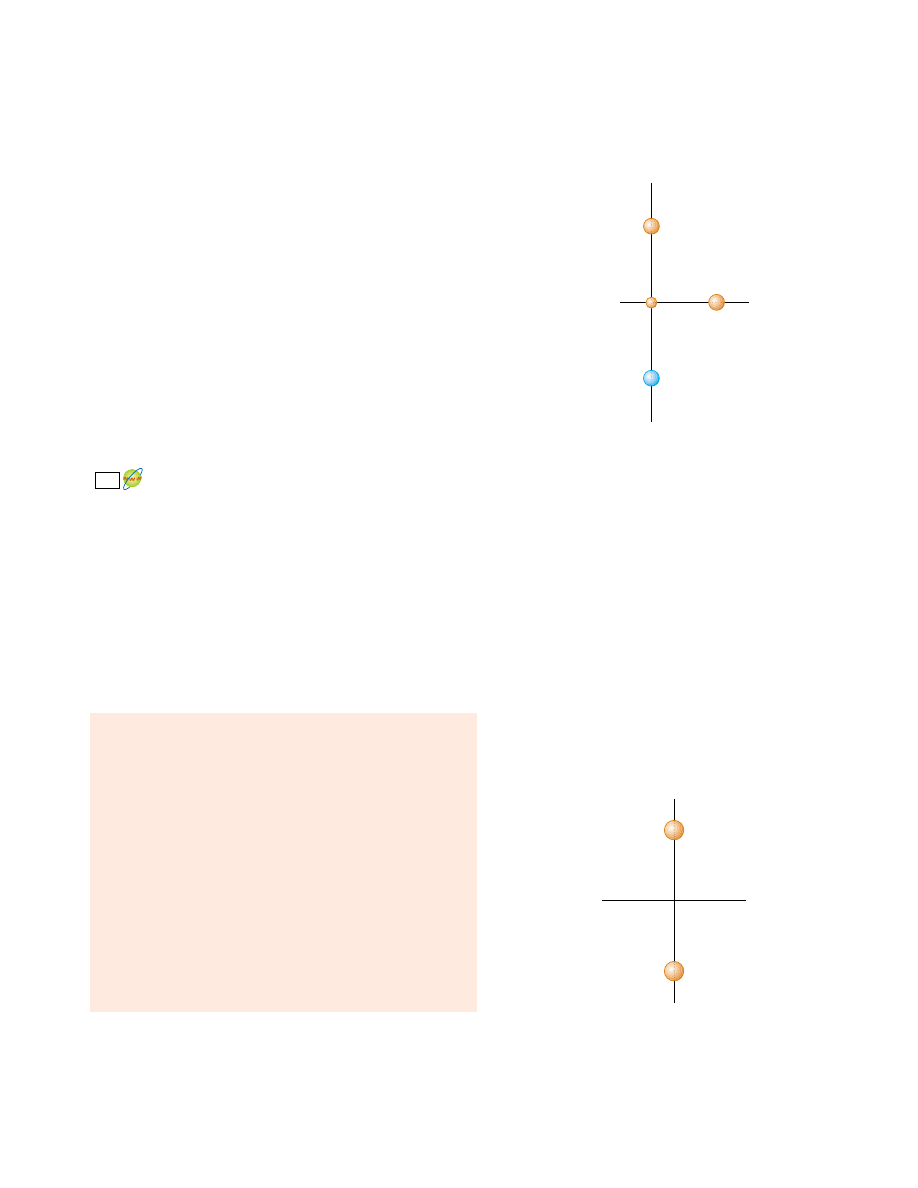Physics For Scientists And Engineers 6E - part 198

Problems
789
20. Two point charges, Q
1
# )
5.00 nC and Q
2
# !
3.00 nC,
are separated by 35.0 cm. (a) What is the potential energy
of the pair? What is the significance of the algebraic sign
of your answer? (b) What is the electric potential at a point
midway between the charges?
21.
Compare this problem with Problem 57 in Chapter 23. Four iden-
tical point charges (q # ) 10.0 +C) are located on the
corners of a rectangle as shown in Figure P23.57. The
dimensions of the rectangle are L # 60.0 cm and
W # 15.0 cm. Calculate the change in electric potential en-
ergy of the system as the charge at the lower left corner in
Figure P23.57 is brought to this position from infinitely far
away. Assume that the other three charges in Figure P23.57
remain fixed in position.
22.
Compare this problem with Problem 20 in Chapter 23. Two
point charges each of magnitude 2.00 +C are located
on the x axis. One is at x # 1.00 m, and the other is at
x # ! 1.00 m. (a) Determine the electric potential on
the y axis at y # 0.500 m. (b) Calculate the change in
electric potential energy of the system as a third charge
of ! 3.00 +C is brought from infinitely far away to a posi-
tion on the y axis at y # 0.500 m.
Show that the amount of work required to assemble
four identical point charges of magnitude Q at the corners
of a square of side s is 5.41k
e
Q
2
/s.
24.
Compare this problem with Problem 23 in Chapter 23. Five equal
negative point charges ! q are placed symmetrically
around a circle of radius R. Calculate the electric potential
at the center of the circle.
25.
Compare this problem with Problem 41 in Chapter 23. Three
equal positive charges q are at the corners of an equilateral
triangle of side a as shown in Figure P23.41. (a) At what
point, if any, in the plane of the charges is the electric
potential zero? (b) What is the electric potential at the
point P due to the two charges at the base of the triangle?
26.
Review problem. Two insulating spheres have radii
0.300 cm and 0.500 cm, masses 0.100 kg and 0.700 kg, and
uniformly distributed charges of ! 2.00 +C and 3.00 +C.
They are released from rest when their centers are sepa-
rated by 1.00 m. (a) How fast will each be moving when
they collide? (Suggestion: consider conservation of energy
and of linear momentum.) (b) What If? If the spheres
were conductors, would the speeds be greater or less than
those calculated in part (a)? Explain.
27.
Review problem. Two insulating spheres have radii r
1
and
r
2
, masses m
1
and m
2
, and uniformly distributed charges
!
q
1
and q
2
. They are released from rest when their centers
are separated by a distance d. (a) How fast is each moving
when they collide? (Suggestion: consider conservation of en-
ergy and conservation of linear momentum.) (b) What If?
If the spheres were conductors, would their speeds be
greater or less than those calculated in part (a)? Explain.
28.
Two particles, with charges of 20.0 nC and ! 20.0 nC, are
placed at the points with coordinates (0, 4.00 cm) and
(0, ! 4.00 cm), as shown in Figure P25.28. A particle with
charge 10.0 nC is located at the origin. (a) Find the
electric potential energy of the configuration of the
23.
three fixed charges. (b) A fourth particle, with a mass of
2.00 % 10
!
13
kg and a charge of 40.0 nC, is released from
rest at the point (3.00 cm, 0). Find its speed after it has
moved freely to a very large distance away.
20.0 nC
10.0 nC
–20.0 nC
40.0 nC
4.00 cm
3.00 cm
4.00 cm
Figure P25.28
a
a
x
y
Q >O
Q
Figure P25.30
31. A small spherical object carries a charge of 8.00 nC. At
what distance from the center of the object is the potential
equal to 100 V? 50.0 V? 25.0 V? Is the spacing of the
equipotentials proportional to the change in potential?
29.
Review problem. A light unstressed spring has length d.
Two identical particles, each with charge q, are connected
to the opposite ends of the spring. The particles are held
stationary a distance d apart and then released at the same
time. The system then oscillates on a horizontal frictionless
table. The spring has a bit of internal kinetic friction, so
the oscillation is damped. The particles eventually stop
vibrating when the distance between them is 3d. Find the
increase in internal energy that appears in the spring
during the oscillations. Assume that the system of the
spring and two charges is isolated.
30.
Two point charges of equal magnitude are located along
the y axis equal distances above and below the x axis, as
shown in Figure P25.30. (a) Plot a graph of the potential
at points along the x axis over the interval ! 3a & x & 3a.
You should plot the potential in units of k
e
Q /a. (b) Let
the charge located at !a be negative and plot the poten-
tial along the y axis over the interval ! 4a & y & 4a.